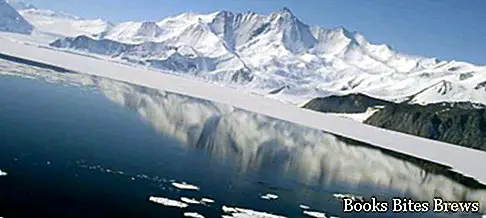Information on the Antarctic region, description of the area, ice, Antarctic oases, climate, human settlements, flora, fauna and scientific research.
Antarctica information
The two parts that make up Antarctica have distinct characteristics.
The eastern part is the largest by extension with an irregular shape that borders largely with the Indian ocean while the western part is formed by an archipelago of islands, which joined in later periods to the main territory, lapped by the Pacific ocean .
Between the two areas, the Transantarctic mountains extend for over three thousand kilometers, characterized by tectonic activities due to the presence of the still active Erebus volcano.
As far as the polar cap is concerned, it can be said that it resembles an elliptical dome almost entirely covering the surface composed of rocks and frequently affected by snowfall and hailstorms made with needles in the shape of ice needles.
The ice masses present in the Antarctic are always moving towards the coasts and reached less cold seas break down into smaller parts giving rise to icebergs which then drift.
Wanting to date the great ice surface that covers Antarctica, it can be said that it originated about 18 million years ago with the end of the Oligocene geological era.
Previously, contrary to what one might believe, the climate was torrid and this is proven by various paleontological tests dating back to 25 million years ago.
Today only an area equal to 2% of the total is not covered by ice, especially in correspondence with the nunatak which are the tops of the hills that rise above the glacial cover.
The Antarctic oases are some fairly large areas that remain ice in a purely exceptional way and in them the climatic conditions are better thanks to the rock that can absorb a greater amount of heat with consequent heating of the atmosphere.
The best-known oases are the dry valleys located mainly within the Transantarctic chain.
Recommended readings- What are latitude and longitude, how are they calculated
- Antarctica: information, territory, Antarctic oasis
- What are the tallest skyscrapers in the world
- How to easily whitewash a room in the house
- How to make the perfect turn-ups for pants
In the Antarctic continent the climate is very varied considering that the average annual temperatures are around 55 degrees below zero near the central eastern area and around 45 degrees in the western area.
As for the monthly average temperatures, they are around 70 degrees below zero in the innermost parts and around 20 degrees below zero near the coastal areas throughout the winter season, while in summer they can oscillate between 0 degrees and 35 degrees below zero.
Precipitation is typically solid without rain.
Much of the continent is swept by strong winds that reach speeds in excess of 100 kilometers per hour and which, blowing with direction from the inside towards the coastal areas, is called katabatic.
Here every living species is scarce due to the severe climatic conditions.
There are plant organisms such as moss and lichen with small alche that live in ice.
Among the animal species, some species of penguins live in Antarctica all year round while seals and birds remain here only in summer.
The marine flora and fauna are more assorted thanks to the warm currents of three oceans which, meeting the cold waters of Antarctica, favor the formation of plankton which allows the food survival of numerous species of fish and cetaceans.
Due to the very harsh climate, there have never been permanent human settlements, we can only report the presence of stable bases exclusively for scientific research.
Among the scientific research carried out in Antarctica the fields of greatest interest concern physics that study the atmosphere, space physics, the study of meteorology, oceanography, glaciology.
Geophysical and geological research is also of great importance as it allows to obtain an assessment of energy and mineral resources to evaluate their possible exploitation.




